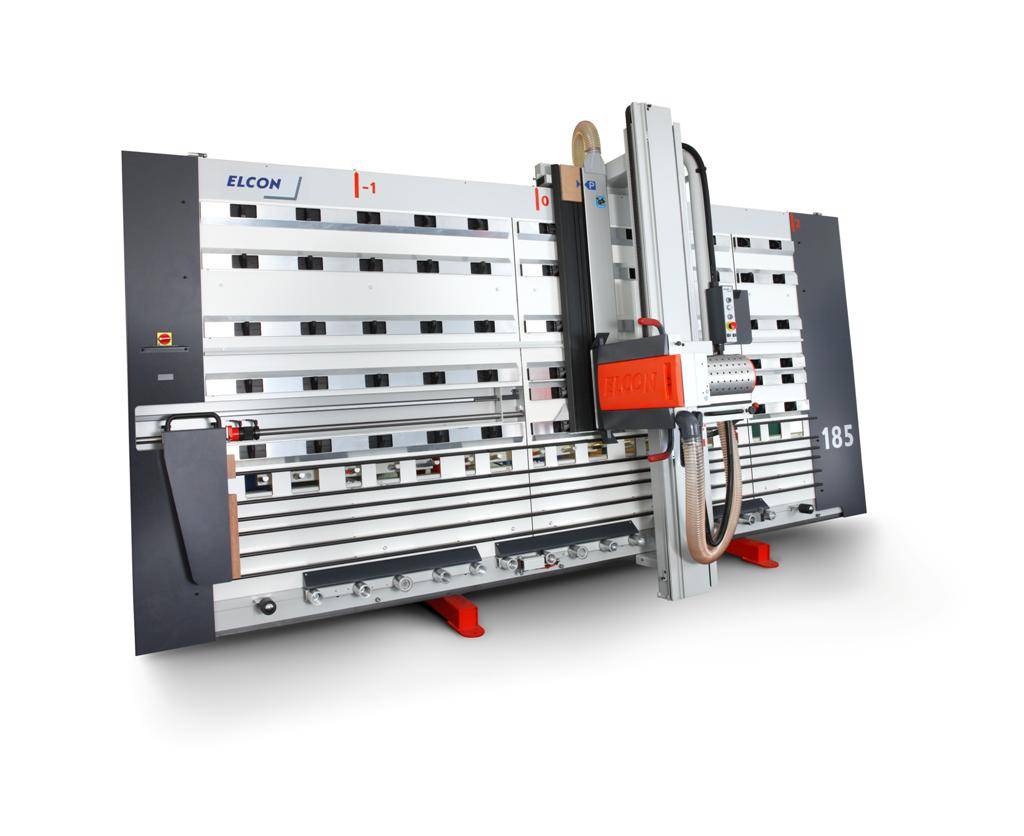Thinking about investing in a vertical panel saw? In this article we explore the pro’s and con’s of vertical panel saws (also known as wall saws) to help you make an informed choice.
A vertical panel saw is an increasingly popular alternative to more traditional sliding table panel saws. Space saving, accurate, easy and safe to use. Wall saws offer some considerable benefits, but there are some important limitations to consider.
To discuss your individual requirements contact one of our experts.
Concept
For those readers that have not used a vertical panel saw or are unfamiliar with the general concept, most machines consist of three key parts; frame, saw beam, saw head. Panels are supported in a vertical, upright position while being cut. The design allows the machine to be positioned right up against a wall, hence the name, wall saw.
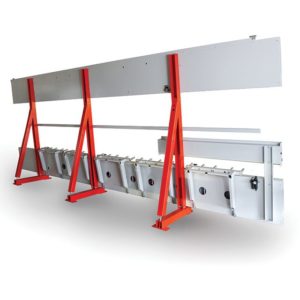
More lightweight ‘mobile’ designs are available that feature a fixed saw beam, requiring the panel to be pushed through the machine. We are focusing on industrial saws for this article which all work in a similar way. The panel is static, fixed against the machine while the saw head and saw beam travel vertically and horizontally respectively performing each cut.
The main frame stands vertically (or rather tilted backwards a few degrees off vertical) and provides support for the panel (see more on panel support below). Acting as the foundation for all the other machine components, the strength of the frame is fundamental to the accuracy of the saw.
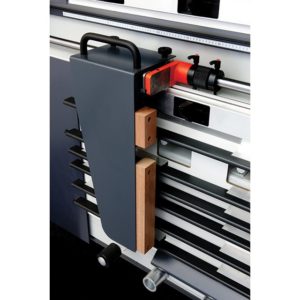
The frame also incorporates one or more adjustable flip down stops (also known as a fence) mounted on the left hand half of the machine that is set when cutting vertically.
Traversing horizontally along the frame, the vertical saw beam carries the saw head. When cutting vertically the beam can be locked in various positions incrementally on the right hand side of the machine. Used in conjunction with the flip down stop, the saw to fence capacity can be increased by 1m for each incremental position.
Finally, the saw head is mounted on the saw beam and traverses vertically. ItIt can be orientated in either a vertical or horizontal position depending on the required cut. The saw blade itself retracts behind the main saw guard allowing the beam and head to pass over panels while loading and setting up, before being plunged into the material to make the cut. The operator, when ready to cut, uses a lever to engage the plunging action.
Application
Vertical panel saws are found in a range of environments and industries the world over. No longer seen as just rough sizing machines, modern walls saws are increasingly used either in conjunction with, or instead of more traditional sliding table saws or saw benches.
Many independent and national timber merchants and DIY stores use vertical panel saws to offer customers a quick and efficient cut to size service, processing all types of wood based panels and worktops. Shop fitting, exhibition contractors and point of sale manufactures often use them for processing larger panels.
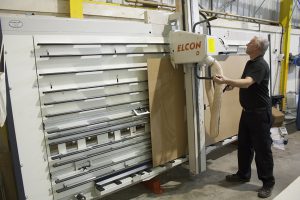
Keeping a board vertical makes handling easier and reduces the overall working area required. Joinery and furniture manufactures employ wall saws in along side a sliding table panel saw. Having a vertical wall saw that can handle large sheet sizes allows them to operate a smaller capacity table saw, again saving valuable workshop space.
It is not just wood based panels that can be cut. Increasingly plastics, composites and non-ferrous metals are being cut. Most manufactures will offer a range of additional options to cope with different materials such as adjustable saw blade speed, mist lubrication, extended cutting capacities, automatic cutting cycle and material handling options.
For more information on the range of applications read our vertical panel saw news stories.
Operation
Two main operations can be carried out on a vertical panel saw; horizontal strip cutting, and vertical ‘crosscutting’. First, a panel (or multiple panels) are loaded onto the machine. Larger/ heavier materials may require two operators for safe manual handling, or a vacuum lifting system can be used. Once loaded, the first sawing operation is usually to trim the length of the board horizontally, cleaning up the edge and proving a precise datum from which the rest of the cuts will be made.
For horizontal cutting the saw head is rotated and locked into the horizontal position. The saw head can then be adjusted up or down the saw beam to set the required height for the cut. The position can be set by eye, or precisely using an incremental rule or electronic digital readout.
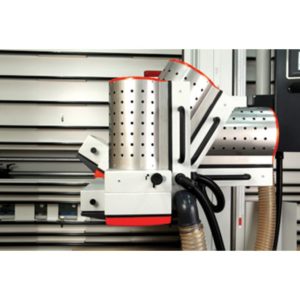
Once set the head is locked off and the beam released allowing it to traverse the length of the machine. Horizontal cuts are made from left to right, so the operator positions the saw head just before the panel on the left, turns on the machine giving the saw a couple of seconds to get up to speed, before plunging the saw head into the material, and then pushes the saw away from them through the cut. At the end of the cut the saw head is retracted and the cycle is complete.
As the cut is made it is often necessary (depending on the size/ weight) to support the strip to prevent it from weighing down on the back of the saw – this is done by the operator using their left free hand, or by inserting wedges. More advanced machines have other methods of dealing with this process that we will look at below.
Once the reference cut has been made the whole panel is rotated through 180 degrees so the clean edge is now sitting squarely on the base of the machine. From here, the rest of the panel can be strip cut horizontally from top to bottom as required. Each strip is removed by the operator and stacked ready for ‘crosscutting’ to final finished dimension.
For vertical cutting the saw beam is locked into place, the saw head rotated back to its vertical position, and unlocked allowing it move freely up and down the saw beam. The flip down saw fence is now used to set the required length to be cut using an incremental scale or electronic digital readout. The strips of panel that have just been cut are loaded back onto the machine, either individually or stacked for multiple cutting, and positioned up against the fence. Vertical cutting is carried out moving he saw from top to bottom – the operator manoeuvres the saw head to just above the panel, plunges the saw head in, and pushes it down through the cut before retracting it at the end. This process is repeated as required.
To make this process simpler, Elcon offer an Advanced clamping system that turns the cutting process on its head removing the need for material handling during the cutting process.
Space, working area and capacity
As with all woodworking machines, vertical panel saws are available in a range of sizes and configurations to suit different types of work. In the UK the most common size machine offers a maximum board capacity of 3300 x 1550 mm, this is enough to accommodate a standard 10 x 5’ or 8 x 4’ board. 3300 mm is the horizontal length capacity, 1550 mm the vertical height capacity. This model would be known as a 155.
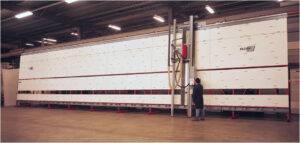
While custom sizes are available (shorter, longer, higher), there are three standard sizes available; 155 (as mentioned above), 185 with a capacity of 3300 x 1850 mm and 215 with a capacity of 4400 x 2150 mm. The working footprint required to operate these models increases with capacity but the front to back depth of the machines do not vary requiring around 1500 mm. See the image below for full working dimensions.
Standard machines, such as the Elcon D and DS models feature a 250 mm diameter saw blade giving a cutting depth of 55 mm for individual or multiple sheets. Increased cutting depth is achieved on larger models such as the Elcon DSX with a 300 mm diameter blade to give up to 80 mm depth of cut. For specialist applications requiring a cutting depth up to 150 mm is also possible with the Elcon TITAN models. Dual saw beams allow the TITAN to be fitted with 450 mm diameter saw blades, ideal for structural insulated panels (SIPS).
Accuracy and cutting quality
Wall saws can be every bit as accurate as sliding table panel saws, but it does depend on the make. When installed and commissioned by factory trained professionals a vertical panel saw will offer years of trouble free, accurate operation. Elcon quote a cutting accuracy of +/- 0.1mm/ m of cut. For example, when cutting a 3300 mm horizontal strip, this equates to a maximum inaccuracy of 0.33 mm across the frame.
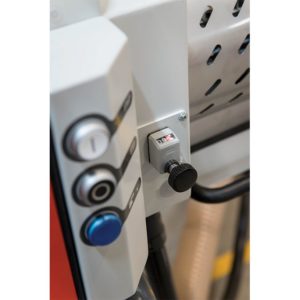
Accuracy is only half the story. The quality of the cut is equally as important and vertical panel saws excel here too. Some models offer a dedicated scoring unit as found on sliding table saws. These should be carefully inspected, as often they are little more than static knifes. In Elcon’s case, they offer a simple and efficient double cut scoring system, available on all models. The main blade is used to reverse cut ‘back-cutting’ with a limited depth of plunge effectively scoring the material before a full plunge cut is carried out resulting in a sharp edge with no breakout. No additional processing time is required as the operator carries out the scoring back-cut when manoeuvring the saw head from the last finish position. This process can be clearly seen in the video clip below. The operator is using an Elcon 215 DSX Advance that includes electro-pneumatic switching of the blade from scoring to full plunge.
Operator safety & ease of use
One of the major benefits of a vertical panel saw is the ease of operation. As you have read, the operation is relatively simple. Additional features such as electronic digital readouts make setting the machine even easier and guarantees
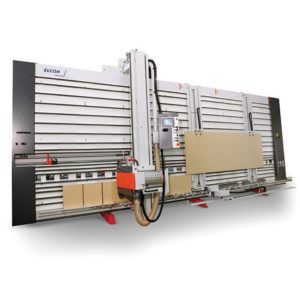
consistent accuracy from operator to operator. For heavier workloads automatic machines, such as the Elcon DSXE, take the strain out of processing large volumes of material.
The entire cutting cycle is automated, requiring the operator to only set the dimension of cut before pressing a button for the machine to take care of the rest. Increasing levels of automation are available in the Elcon range, automatic setting, cutting list input, ADVANCE panel handling, all culminating in the QUADRA – the most advanced vertical panel saw available.
The most dangerous part of the machine, the saw blade, retracts behind its own guard when not in use. In addition, a sprung loaded safety pressure shoe surrounds the blade when cutting, securing the work piece and making it almost impossible for the operator to cut anything other than the material.
Improper use and lack of training are the main causes of accidents on woodworking machines. Remember, it is a requirement under law that all operators must receive adequate training. See our woodworking machine training section for more information on our range of woodworking machine safety training courses.
‘Inexperienced operators have accidentally touched the saw blade when they: have pushed the panel towards the saw rather than bringing the saw to the panel; have had to hold panels because they were either below the safe minimum cutting size or were bowed or irregularly shaped; and were unaware that there was an operating saw blade within the enclosed guard.’ – Health and Safety Executive.
Dust Extraction
An area often overlooked by customers when considering the purchase of a vertical panel saw is dust extraction. This is an extremely important aspect of any woodworking machine, and, as you might expect, there are options for this too.
As a minimum there is an extraction point from the saw head itself. The majority of the
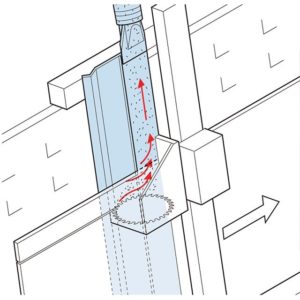
blade sits within the saw head guard even during cutting, and this provides adequate dust removal for most operations. When cutting fibrous material such as MDF, or cementitious material such as Gypsum, on a regular basis additional extraction methods should be considered to minimise operators exposure to potentially harmful dust.
For maximum extraction efficiency the LIMPIO system, patented by Elcon, includes a rear dust capture tray. With its own secondary extraction point that travels directly behind the saw head whether cutting vertically or horizontally. Extracting dust from both sides of the cut, dust emission values are reduced to less than 0.5 mg/ m3.
It is important to remember that the machines themselves do not include a dust extraction unit. The above dust removal methods will only function properly when connected to a suitable extraction system. For more information see our range of industrial dust units or contact a member of our team.
Limitations
So, as we have seen wall saws offer a number of advantages. A space saving, safe and accurate method for sizing panels. ‘Great. So let me buy one!’, I hear you say. OK, but before that lets take a look at the limitations of a vertical panel saw to ensure it will be right for your production.
Vertical panel saws are only designed for cutting panels at 90 degrees, vertically and horizontally. While most vertical panel saw manufactures offer some sort of panel tilting device, they are in reality cumbersome and should only be considered for limited use. If you cut mitres on anything like a regular basis a wall saw is not for you. The same is true for bevel cuts. There are only one or two manufactures that offer the ability to angle the saw head for a bevel cut. Consider this feature with caution. The added functionality presents some potential health and safety issues, weakens the overall design and often leads to problems with accuracy.
There is also a limitation on the minimum panel size you can safely start working with. Different manufactures will no doubt have their own specifics on this. However, in our opinion the smallest work piece size should be no less than 300 x 300 mm. Creating finished components smaller than 300 x 300 mm is not a problem, just so long as they are cut from a larger panel.
For ultimate versatility you can’t beat a sliding table panel saw. Mitre and bevel cuts can be quickly set and accurately cut. They can also be used for solid timber ripping. The trade off is the overall working area with a typical sliding table of 3.2 m capacity requiring an operational footprint of almost 7m.
Summary
Vertical panel saws are the ideal solution for companies that require fast and efficient panel sizing at 90 degrees. The ease of use and inherent safety features reduces (but does not eliminate) the time required for training new operators. Advanced features can further increase production efficiency and guarantee consistent accuracy with all operators. The fundamental design has the advantages of reducing the impact on work shop space and makes material handling easier.
More information and further reading
The Health and Safety Executive information sheet ‘Horizontal beam and vertical panel saws’ offers further information on safe operation and guarding http://www.hse.gov.uk/pubns/wis3.pdf
The Health and Safety Executive information sheet ‘Wood Dust – Controlling the risks’ http://www.hse.gov.uk/pubns/wis23.pdf
The Health and Safety Executive guide ‘Manual Handling Solutions in Woodworking’ http://www.hse.gov.uk/pubns/indg318.pdf
View our full range of vertical panel saws Talk to one of our experts
